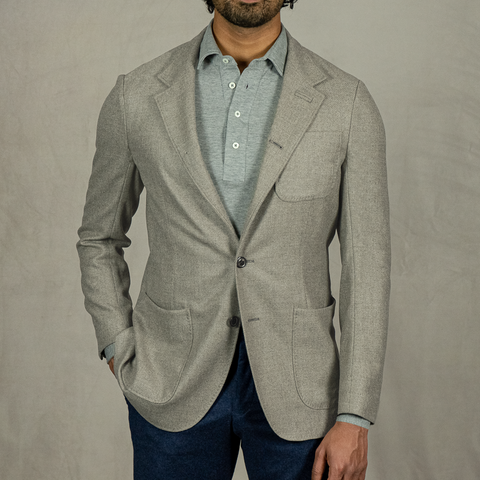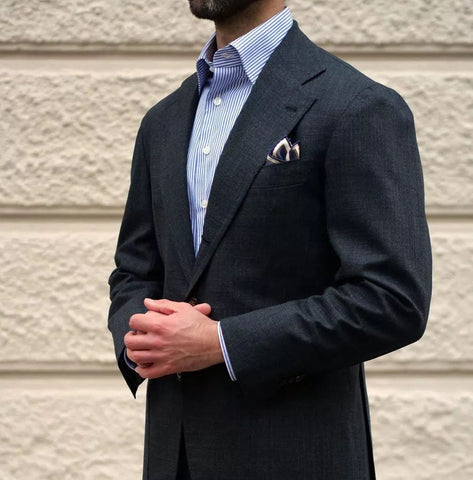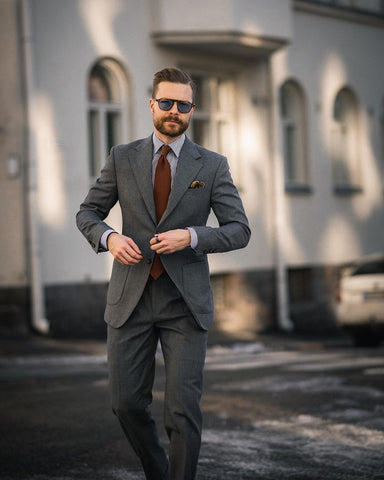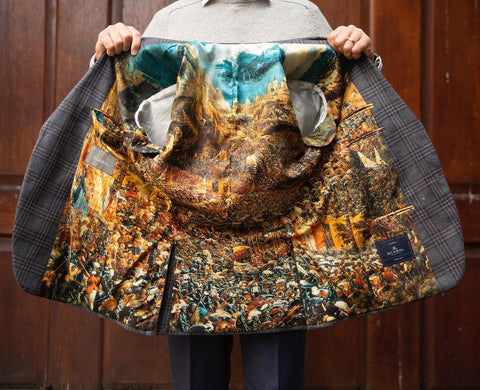The Complete Guide To A Tailored Jacket or Blazer
The right tailored jacket or blazer is a crucial item to have in your wardrobe. It can complement many styles and outfits, work for all types of events and occasions and become a long-lasting piece of clothing for you to adore.
As part of our Details Video Series, we explore the key components that make up a tailored jacket. From the importance of the lapels, to the benefits of using natural fibres, our informative and product focussed videos delve deeper into the main elements of a tailored jacket.
The Importance of Jacket Lapels
The lapel on any tailored jacket is an important feature as this creates the taste and style for the jackets proportions and view to the eye. The base of the lapel should have a beautiful soft roll that accentuates the 3-dimensional element of the lapel and draws the eye to the waist.
The top of the lapel is a defining feature of any jacket. The most versatile and standard style is a notch lapel, as featured in the video. The lapel should be moderate in size, neither too skinny or wide to create a nice overall proportion. Finally, the position of the notch lapel should ideally be at the same point as your tie knot as this will create a nice balance to the overall look.
Notch vs Peak Lapels
Tailored jackets can have a variety of lapel types but the most commonly seen as either peak or notch lapels.
The lapel is an essential feature of any jacket to define its shape and visual setting. The lapel shape is typically seen across two classic types: a peak lapel and a notch lapel.
A peak lapel has a broader setting and points towards the shoulder. It's usually seen on double-breasted jackets but wouldn't be out of place on a single-breasted jacket either. Peak lapels tend to be more visually prominent and striking, so they are often seen on formal options such as dinner suits or cocktail jackets.
A notch lapel is when the lapel is sewn onto the collar of a jacket at an angle, creating a triangle between the two. The notch lapel is a classic style and is appropriate for any single-breasted jacket, such as a sports jacket, blazer, or a single-breasted business suit.
Our collection uses notch lapels as standard as it's the most versatile jacket type, which can be either dressed up or down to suit all occasions.
The Importance of Shoulder Padding
After the lapel, one of the most defining features of a jacket is the shoulder line and the amount of padding that is included. The level of padding can really alter the feel and taste of the garment.
Currently there are a lot of trends and movements towards using unstructured blazers with unpadded natural shoulders, which have their place within menswear but are more suited to more informal garments and occasions.
However, a natural shoulder line with light padding keeps the shoulder nice and clean but doesn't add any bulk to the jacket. This means you still have a nice slope and structure to the shoulders.
Light shoulder padding should create a straight line from the collar to sleeve head. This creates an elegant finish and structure to the jacket, allowing the garment to hang properly.
A slightly more built up shoulder can also create a strong definition and elegance to any jacket, however, we would recommend they are made by specialist bespoke tailors. This ensures the sleeve pitch is aligned perfectly, and the upmost precision and care is taken otherwise the jacket can look quite dated.
Is Shoulder Padding Out of Date?
Shoulder padding has been a longtime standard within tailoring, offering jackets structure and support across the shoulders and sleeves. However, style trends change over time and as part of our Video Style Series, Leah and fashion consultant Chris Modoo explore if heavy shoulder padding is now out of date.
In the video, Leah and Chris explore the different levels of padding you can use across your jacket shoulders. From no padding to heavy shoulder pads, each has their own purpose and benefits to suit the type of jacket you may be looking for.
Difference Between a Tailored Jacket and A Tight Fitting Jacket
Lapels and shoulder padding are extremely important elements of a tailored jacket, but are in vain if it doesn’t fit you perfectly. It may come as a surprise, but buying a jacket online that fits beautifully is actually a surprisingly simple process if you take a few comparison measurements off one of your own jackets.
The main point of measure to ensure your jacket is not too tight is the shoulders, it’s really crucial to get a well fitting shoulder. Ensure you look at size charts when purchasing online to understand your key measurements.
Known as the point to point measurement, measure across the back of the shoulders from the seam of the sleeve head to the opposite seam. This is an important measurement as some people typically wear the same size but have different shoulder widths.
In our video below, we explore the main differences between a tailored jacket vs a tight one, including the four key signs to watch out for that your jacket is fitting too tight.
What Are the Benefits of Using Natural Fibres?
Choosing the right fabric is key to ensuring the perfect jacket lasts you a lifetime. The correct fabric will ensure a clean hand-feel, texture to the audiences eye and a durable product.
We would always recommend using natural fibres for a tailored jacket, with wool, linen or cashmere being our personal preferences. These types of natural fibres tailor beautifully, feel nice to the touch, and provide the wearer with ultimate comfort.

Man-made or synthetic fibres such as polyester can often feel flat and uncomfortable as they have a shiny crinkly feel which isn't pleasant. We would always suggest a natural fibre over synthetic when it comes to your jacket.
The Significance of a Jacket Lining
The lining is a layer of fabric between the wearer and the outer shell of the jacket, used primarily for comfort and functional pockets, it can also bring an element of design and style.
Often people talk about jacket lining and their first impression is the colour and design. Lining designs can add interest to the jacket, showing off your creative side. However, the lining is an important element of a jacket for comfort and drape.
The lining is the cloth between the outer fabric shell and the wearer and allows the jacket to hang better and ultimately, feel more comfortable.
Why are Pockets on a Jacket Stitched Closed?
Simply put, the main reason that jacket pockets are stitched closed is to keep them in good shape within transit, and to avoid creasing. To remove, simply use a sharp knife to take the base stitching out. You may also see a branded label on the cuff of your jacket.
This was historically used to identify each jacket and brand within a department store, such as Selfridges. These can also be removed easily with a sharp knife and ideally, should always be removed before wearing.
How do Pockets Effect the Style of the Jacket?
The pockets used within your tailored jacket can have a huge influence on how formal looking the garment is. The tailored jacket used in the video has side patch pockets, which are slightly more informal. This style of pocket dresses it down a little but should be still be considered very elegant.


A more formal way of finishing the pocket would be for two straight slicks, used more on evening or dinner suits. Another option on the finishing is for the pockets to have flaps which adds interest into the shape and style of your jacket.
What are Working Button Cuffs?
Working cuffs taken literally are the buttons on the sleeve have real buttons holes to open and close the sleeve of your tailored jacket. The history behind working cuffs is based on being used by surgeons and clerics for practicality whilst working. Nowadays, the addition of a working cuff is a nice attention to detail, usually seen on luxury or high-end jackets.
Most people tend to not leave their working cuff buttons undone, however you may want to undo one or two in the warmer months for comfort.
What are the Correct Number of Buttons on a Jacket?
The number of buttons used on the front of a jacket is really crucial and can alter the style of your coat. The two button jacket by far most popular at present and creates a lovely shape in the waist by buttoning at the narrowest point. The rule here is to never do the second button up, as this will ensure a natural drape and means the jacket will gently skirt away at the waist point.

Other styles seen across jackets are one button, which are popular for evening wear or formal dressing. Three buttons jackets are less popular nowadays but work well for sporty coats or outdoor garment fabrics, such as tweed.
What Can Be Altered on a Tailored Jacket?
Your tailor can alter a vast number of jacket parts to ensure the perfect fit but there are some alterations that are easier then other. We recommend only trusting an experienced tailor to ensure your jacket stays in pristine condition.
The main alterations usually achieved on a tailored jacker include the sleeve length, which can be adjusted by 2cm without affecting the shoulder. The waist can also be taken in via the side seams by about 1.5cm for more suppression. If your jacket if fitting too wide, a master tailor can chip in the shoulder seam and narrow the fit of the body.

There are some areas we suggest to avoid altering, such as the jacket length. It is impossible to add fabric and lengthen your jacket, but you can make it shorter by no more than 1.5cm, otherwise your pockets will look out of proportion.
Finally, avoid playing with the centre back seam. It may seem easy to take in the sides but this can actually affect the drape and shape of how your jacket hangs.
How Much Shirt Cuff Should You Show?
We often get asked, how much shirt cuff should you show under a jacket? The choice is personal preference but showing your cuff under the sleeve breaks up the jacket, makes the skin look lighter in tone and can give an overall sharp and clean finish. The same way a shirt collar breaks up the jacket across the neck and chest, the same thing applies here with your hand.
There are varying opinions within tailoring about how much cuff should be on show. American tailors often show at least an inch of shirt cuff as standard. However, British style tailoring shows slightly less cuff traditionally. As a rule of thumb, we would suggest anything between a quarter inch and one inch of shirt cuff showing will look elegant and smart.
Does the Length Vary to What You Are Wearing?
Dinner suits or more formal suits, especially if you are wearing cufflinks, look best with a good amount of cuff on show. However, if you are wearing a sports jacket or a more casual blazer, we suggest opting for a slightly longer sleeve length over your cuff.
What Feature of a Jacket Gives It Is Style
The classic tailored jacket has many key features making it unique and smart looking. The lapel on a tailored jacket one of the most important feature, it gives the jacket its taste and style.


The lapel has a soft roll and extenuates the three-dimensional elements of tailoring and draws the eye to the waist. It’s also important where the notch of the lapel of positioned, as it should be in line with the tie point to create a visually appealing look.
Tips When Travelling With A Tailored Jacket
We often get asked about the best tips for keeping your tailoring pristine while travelling. Ensuring your tailored jacket or blazer stay fresh and ready for any occasion can be a challenge whilst travelling. A tailored jacket is three-dimensional by nature and can therefore get easily get flatted and creased while in a suitcase.
Our best tip to keep your tailored jacket crease free is to empty all the pockets, unbutton, and hang in bathroom using a correct and full shoulder hanger. You can steam the jacket yourself using a hand-held travel steamer or simply allow for a natural steam from the hot water by running a shower.
Easy Ways You Can Ruin Your Tailored Jacket
If you purchase a tailored jacket, you expect it to be durable, long-lasting and to be kept in pristine condition. However, there are some daily habits which can ruin your tailored jacket or blazer.
For example, it’s advisable to never use wire coat hangers as they don’t support the jacket. If you dry-clean your jacket, sometimes they are returned on wire coat hangers, but these should be instantly replaced. Use a correct jacket hanger with a wide support, which will ensure the jacket hangs correctly and fits better.

If you are in the office or outside of your home, try and always hang your jacket correctly rather than place on back of a chair. For prolonged wear, hang your jacket whenever in the office or travelling, this will ensure the jacket will hold it’s shape better. If out for dinner for short periods of time, it’s okay to rest your jacket on the back of the chair on the odd occasion, but for no longer than 40 minutes.
HOW TO MEASURE A TAILORED JACKET OR BLAZER FOR BUYING ONLINE
Buying a jacket online that fits beautifully is actually a surprisingly simple process if you take a few comparison measurements off one of your own jackets. In summary there are four key measurement points you should understand how to take correctly.
- Shoulder Width (know as the Point to Point measurement)
- Jacket Length
- Jacket Sleeve
- Waist Measurement
MEASURING OVERVIEW
There are two main things to keep in mind. The most important measurement is the shoulder width (known as the point to point measurement), shown first in the video. The reason for this is as long as the jacket fits across the shoulders, almost all other aspects can be adjusted by your local alterations tailor who tend to be very affordable.
The other rule of thumb is, if you are in doubt between two sizes, always go for the larger size as a jacket can be taken in, e.g. waist, length, sleeves etc, but can't generally be taken out.
If you have any questions or comments then please email us info@rampleyandco.com and our team will be more than happy to help.
WHY BUY A RAMPLEY & CO TAILORED JACKET?
Fit is incredibly important to us and so our tailored jackets are designed to look good across all body shapes, ensuring you always look and feel your best. We offer two fits, slim and regular, as well as allowing you to choose the perfect length to suit your torso and arms. We recommend you take a look at our comprehensive size guide which gives a full overview of the sizing should you wish to check against another jacket here: Jacket Size Guide.
As well as being constructed from fabric supplied by the world renowned Scabal of Savile Row, what makes our jackets truly exceptional is the ability to select your choice of lining (included in the total price). Your lining is not about being extravagant, but ensuring you have something personal to you. We have a large selection of jacket linings, but also offer a bespoke service should you want a truly one-of-a-kind jacket.
Once you have purchased your jacket, one of our team will follow up with you to double check the details and answer any further questions. Your satisfaction is absolutely guaranteed, so you can be sure that you will be delivered a jacket that exceeds your expectations.















